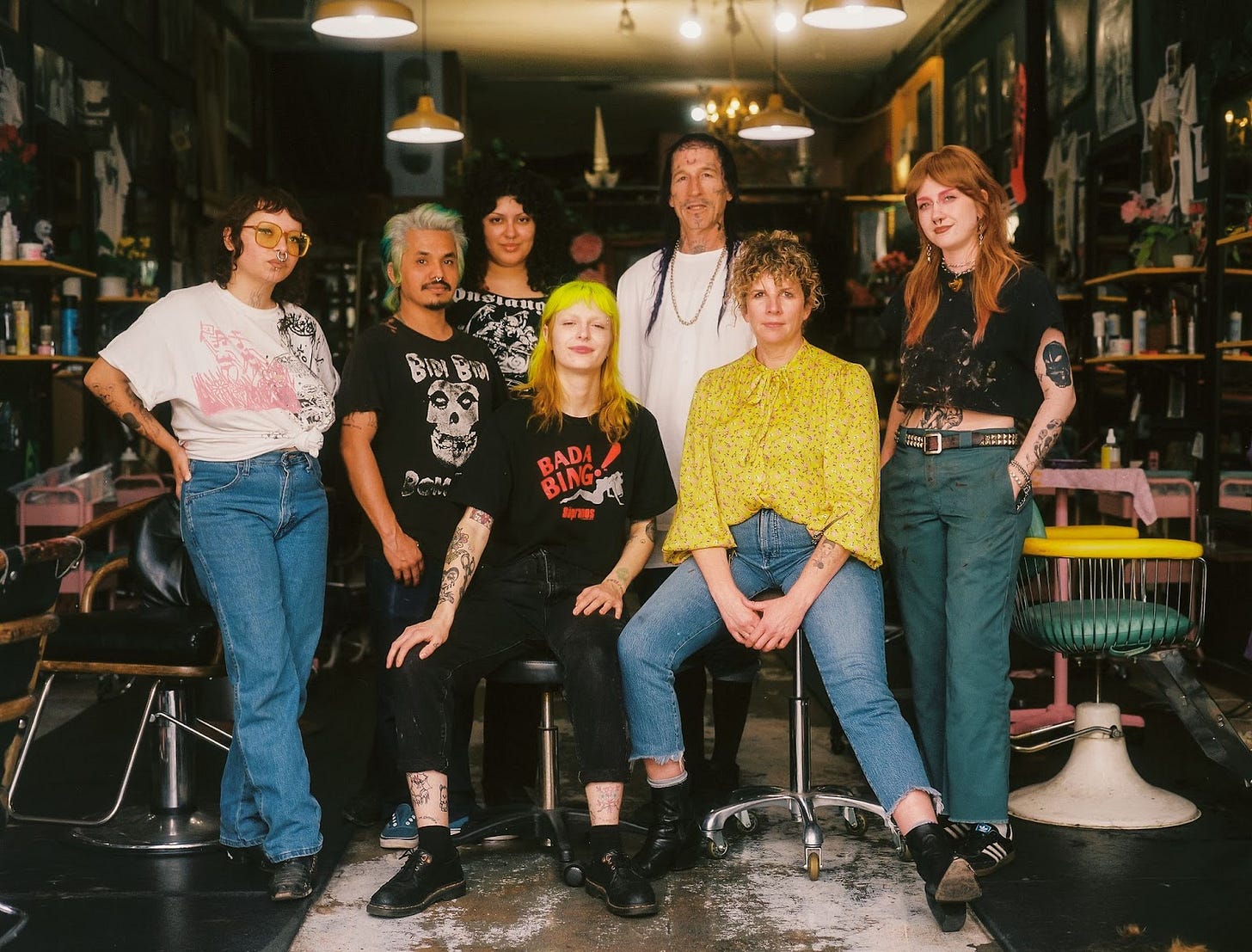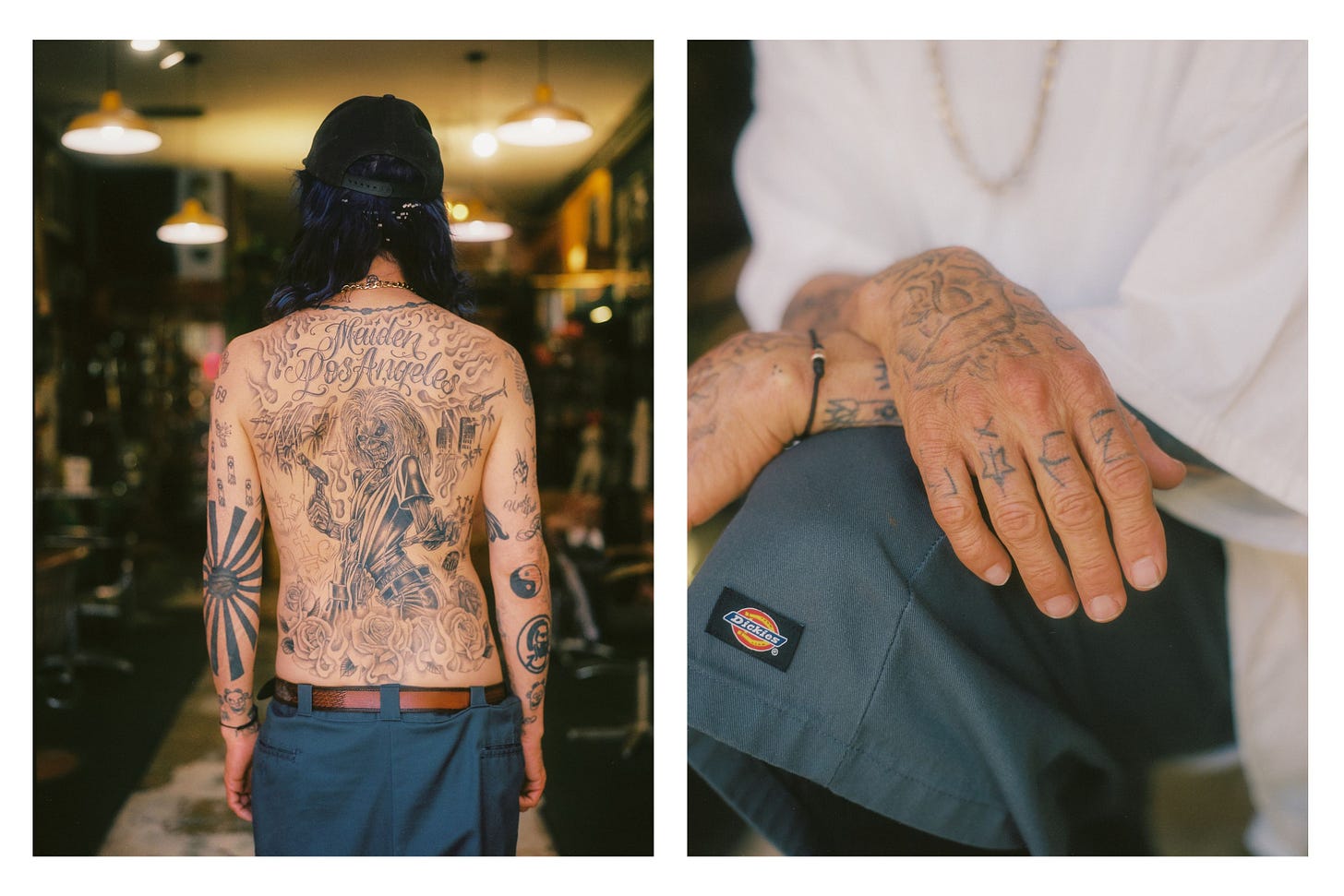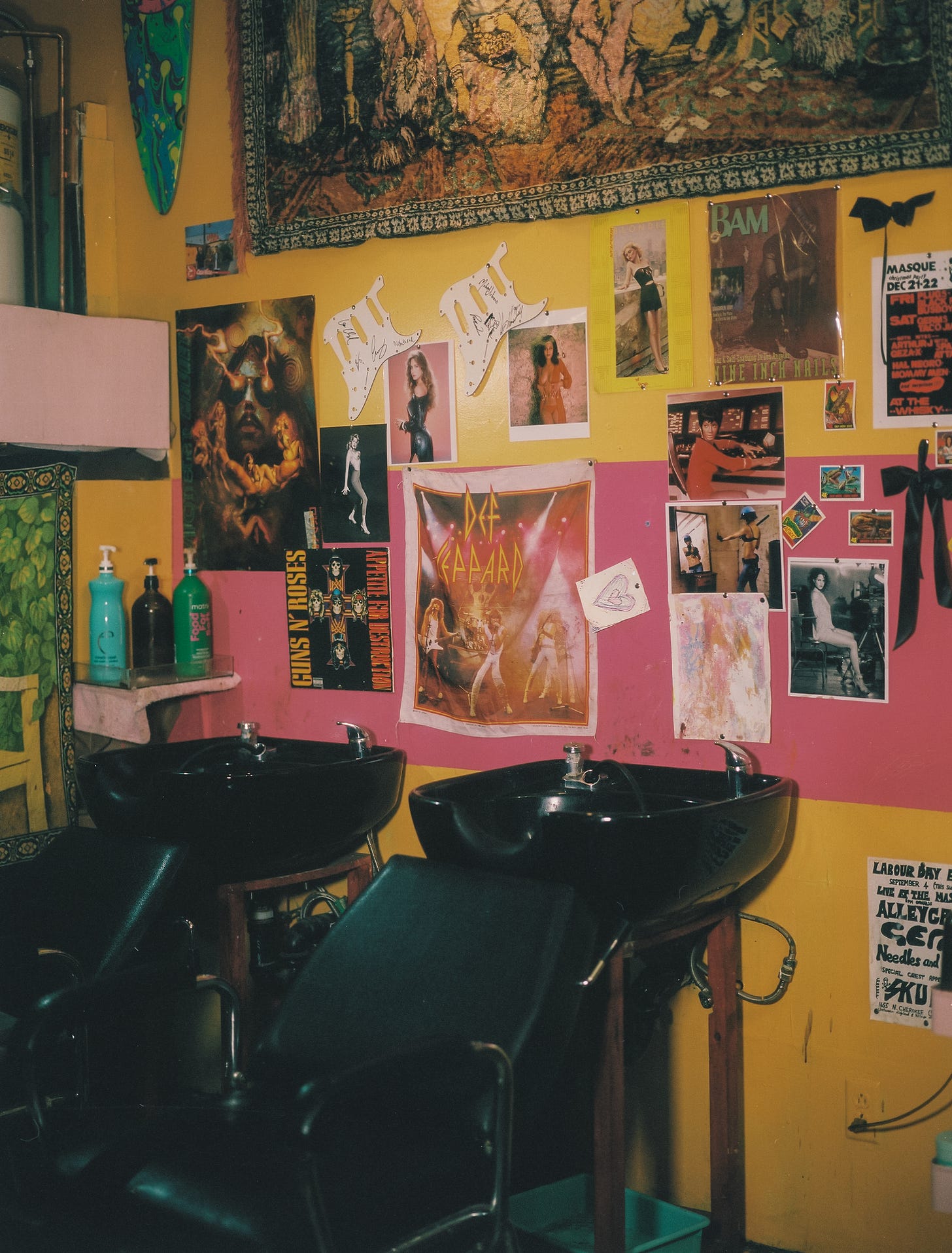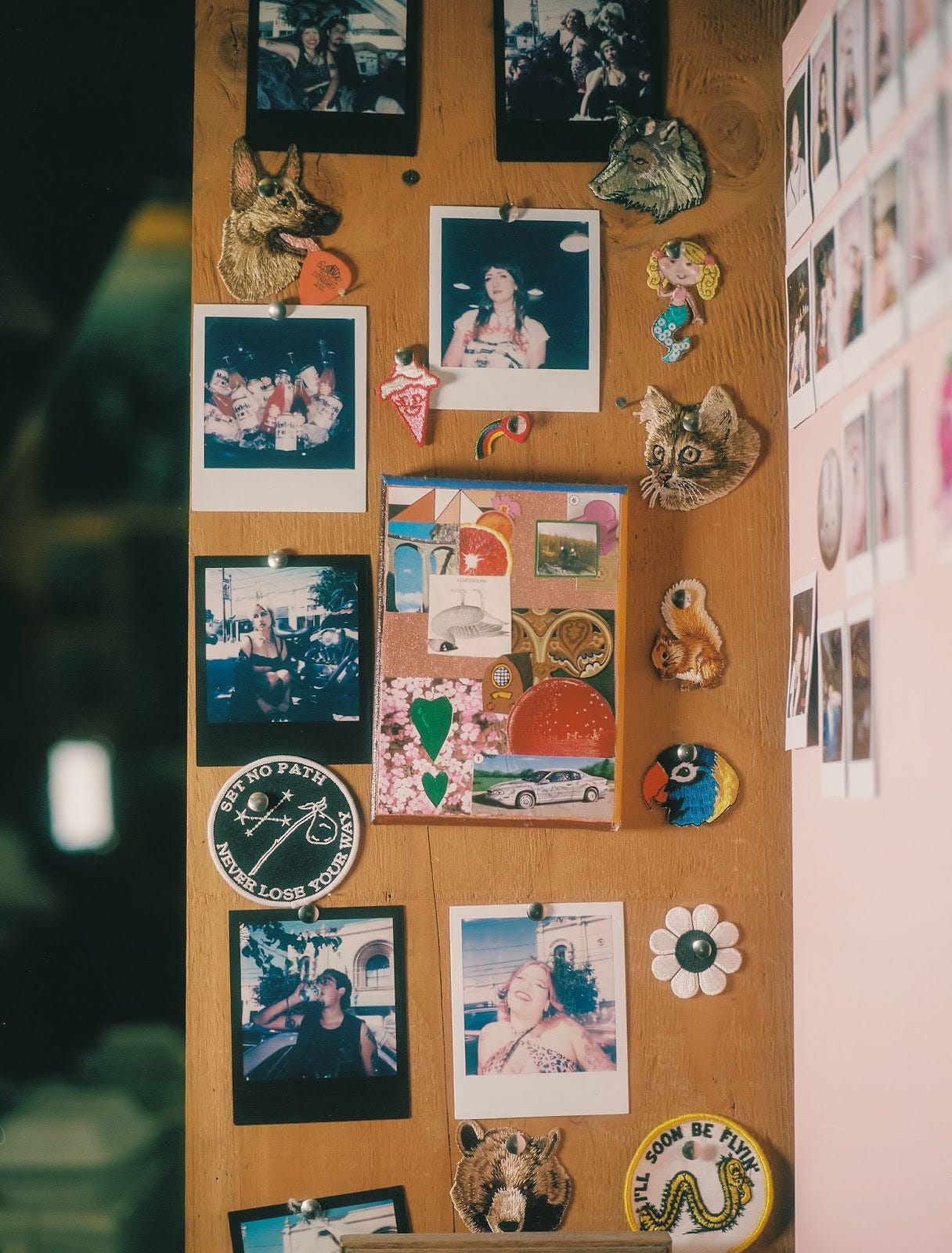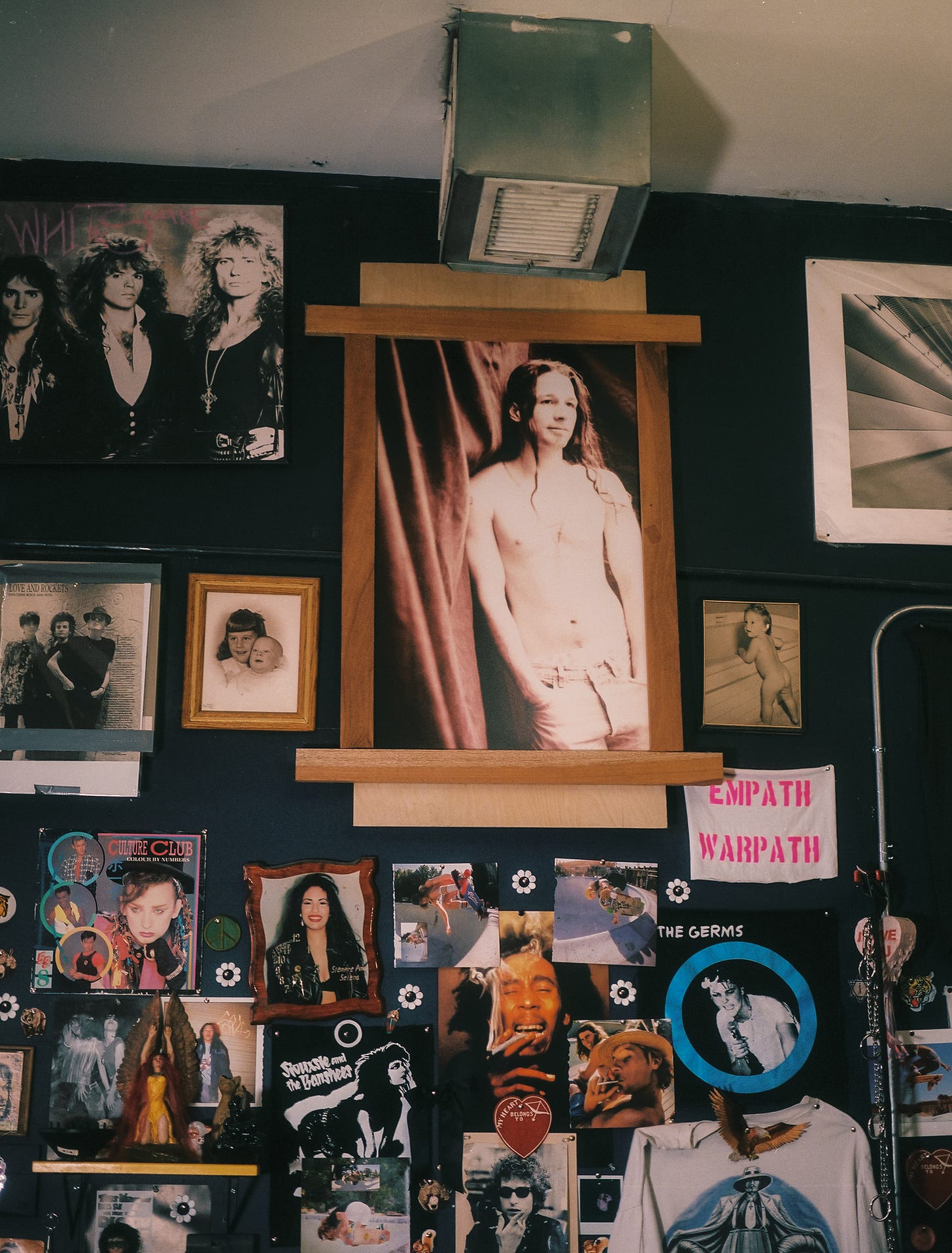A neighborhood hair salon with a side of LA underground history
Julio Romano, owner of Shampoolio in East Hollywood, speaks at length about opening a salon for the "wild cards" and what it was like to grow up as a rebellious punk kid in 1980s central LA.
On Melrose Avenue, just west of Vermont, there’s a hair salon like no other. This is not the typical minimalist, sterile salon common in gentrifying neighborhoods. Inside, the walls are painted black and covered with images of musicians ranging from The Germs and Siouxsie and the Banshees to Selena and Bob Marley, punk show fliers from the 80s and 90s, black and white photos of the owner, and band t-shirts. Each station is like its own altar to the stylist’s personality and interests. Salon chairs are vintage or thrifted. The wash station walls are bright pink and yellow with tacked on posters of hair metal bands and 80s models. Blaring through the speakers on any given day could be a Dirty South, punk or trap playlist.
After years of working at celebrity hair salons, Julio Romano decided to open Shampoolio in 2012. His vision: to create a salon that isn’t stuffy, or stuck up, is welcoming to the freaks and weirdos, and acknowledges hair styling as an artform.
A salon like this can only come from the mind of someone like Julio. A born and raised LA local, he’s instantly recognizable on the streets, covered in tattoos, wearing baggy clothes and long bright hair, riding his bike with his chihuahua, Morris.
Shampoolio is a manifestation of Julio’s punk, hip hop, 80s and 90s central LA upbringing, which included moshing with the local cholos, attending goth parties in MacArthur Park’s Park Plaza Hotel, and climbing the Hollywood sign. He’s created a space that’s reflective of his LA, where subcultures can co-exist, and people can feel free to experiment.
I recently spoke with him at length to learn more about what it was like growing up in central LA as a punk kid, getting out of the celebrity hair business of the westside, and opening up Shampoolio. What follows is effectively an oral history of underground LA, as delivered by Julio and transcribed by me in the summer of 2024.
Upbringing and early years:
My mother was a free spirit, a gypsy, hippie, as was my father. But then after a few too many acid trips, he decided he better work for God. He then became born again. We left and moved to what is now North Hollywood.
By the time I became a force in the neighborhood, they moved us right to Hollywood. My stepfather became a successful musician and was producing and playing on a lot of records like Donna Summer, Devo, Billy Idol.
We were smack underneath the Hollywood sign. When we went to play, it was on the Hollywood sign, in the dirt below it and climbing up and down around because we didn't have a park. When you live up there, you're stuck. To get down, it's a mile down. We would also stay up and play in the hills.
Back then there was no fence around the Hollywood sign. You could climb onto each letter and you could hang out. You could have lunch there. You could go on a date there. You could smoke a cigarette there. You could dream about all of your dreams or you could think about the people who had jumped off.
We had our own fantasy world going and we were obsessed with that. And we're also starting to go to shows at all ages venues like the Troubadour where we could see metal and punk bands.
And then I had two older sisters and an older brother, so they were immersed already in the more grownup punk and metal scenes. My sister Lisa started dating Greg Hedson from the Circle Jerks, and he's the founding guitar player. So they were already rehearsing in our living room and on the weekend would play house parties and shows right there in our living room.
I was also hanging out with all these older kids and they had style and they looked cool and they had Mohawks and tattoos already. They wore Creepers. They dressed really dope and they were personalities.
We spent two years in Hollywood. My parents got a divorce and then we moved to Silver Lake because my mother had a bunch of queer friends from Silver Lake. They convinced her to move there because there was a community of people there that could help her.
Once I came to Silver Lake, we moved right across the street from the basketball courts in where the park is right there on Silver Lake Boulevard. I changed schools to King.
I started realizing that I had friends that had two dads. And so we would go to their house, and then you realize, wow, these are queer families. That was the norm.
Those kids were super cool. They taught us how to cut hair. They would razor cut their hair. They already wore crops and charged out hairdos cause they could do their own hair. These kids were 13, 14 years old, and they were already that savvy and obsessed with punk and death metal and skateboarding.
All of a sudden I had this group of friends I was running with that were more savvy, more Latino, spoke a hell of a lot of Spanish and knew how to get around downtown, MacArthur Park, Hollywood, Silver Lake, all the way even into Long Beach where a lot of punk shows were happening.
Later on when I met my most important mentors, they were all living in Silver Lake during that same time. And they were Latino queer men, but we met in West Hollywood. We're talking about the masters of the industry like David Bowie's hairstylist and Prince's hairstylist.
When I opened this place, they came and helped me out of respect. Cause I worked for them for 18 years.
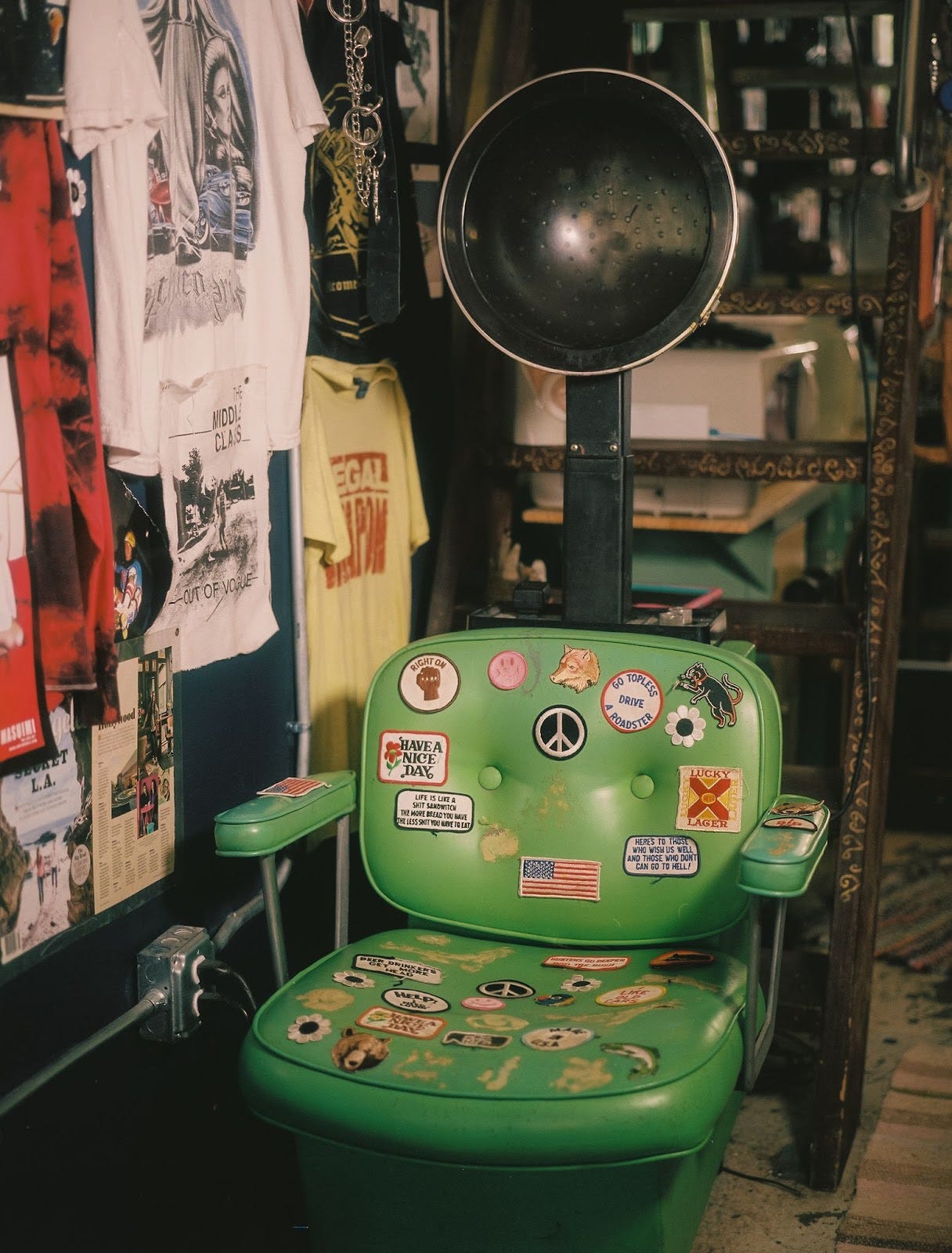
Julio’s high school years running around Silver Lake:
I went to Marshall [High school]. I had joined the Silver Lake Stoners clique. We were a gang, but we didn't fight. We had and sold weed. We knew all the other gangs and they liked us because we all had long hair and we always had weed and we were into metal.That was how we were able to operate.
The only other people that were into metal that were gangbangers were MS. Because before they migrated here, death metal and punk somehow leaked into their country. By the time they came to America and established their roots they were where the bands were and they could get access.
MS at that time was Virgil and above, between Santa Monica Boulevard down to Beverly.
They went to all the shows. They all had the dopest long hair and looked like the sickest death metal dudes ever. If you were in the pit, they would back you up cause they knew us from the neighborhood.
Central LA punk venues and goth underground spaces of the 1980s:
There was a club right here called the Anti Club, which was on Melrose and Normandy, which was a club where punks, queers, and cholos would hang out there. It was very ahead of its time. Some of the major monumental punk shows were there. It was a real gritty venue.
Punk and metal were getting very popular [in my youth]. Slayer even played on Sunset and Vermont. There was a venue right there. We got to go to those earliest shows and pay five bucks and go see them cut the head off the mannequin and throw fake blood.
Then there were a lot of after hours clubs, illegal clubs were happening a lot in this general area right here. A lot of underground stuff happened here.
I remember in high school going to my first goth club at Park Plaza across from MacArthur Park, and for the first time seeing people that their look was so important. The outfits, the hair, the eyeliner, the time it took to get ready, the accessories, the jewelry, the gloves, the chokers, the leather.
A lot of this was happening simultaneously here and in London and New York for the first time. So we were just lucky enough to be dumb enough to go and try to look for these places.
Back then, you could be queer, you could be straight, you could be Black, you could be white, Filipino, Japanese, Chinese, we had it all. No one was really gonna check you unless you were a dick.
These places were created for everybody, for the outcasts. And that's who we all were. We didn't fit in at homecoming or the prom. We went to our clubs.
I think that really set me up to open this spot [Shampoolio]. Because there's certain authenticity, and I really wanted it to feel like a space that I went to back then.. Plus, this place was built in the 20s, it has an old vibe, and we wanted to honor that.
All those venues are gone now. There are condos where the Anti Club was.

The hip hop club in 1980s East Hollywood:
I just remembered the first hip hop [club/venue] in LA opened in East Hollywood where Home Depot is now.
It was called Water the Bush. We knew the door girl cause we went to Marshall with her and she had worked her way into that world.
So getting in there, Ice T, Easy E, Grandmaster Flash, George Clinton, you name it, are in there smoking blunts, spliffs, drinking. There were never cops, never a problem. They left us alone. The parking lot was full of gangster rides.
Boo-Yaa T.R.I.B.E. used to work security there. They became a hip hop group that actually charted during the late 80s early 90s and became a big thing. They were all Carson bloods that were like six six, six eight, fucking yoked. They all had long hair that was braided. When they would perform, they would dance and move in sequence and shake their braids.
Seeing that at a young age was wild. We were able to tap into it just from living here.
Silver Lake in the 80s and 90s:
On Sunset Junction, Exene from the punk band X had a store there called, You Got Bad Taste. She was there selling things on her days off from the band. Then right down the street from there at Millie's, the singer from the Circle Jerks was the head chef there. That was a punk scene too. They were known for being the rudest waiters in the whole world.
And they had shirts that said Millie's “Service with a fuck you.” On any given day when they weren't on tour, you could visit two monumental punk icons only blocks away.
Then there was the Silver Lake Street Fair where the Cramps would play and X would play and all these great bands would play. The gang members in the neighborhood would work security. It rocked all through the late 80s into the 90s and the early 2000s with the best lineups of punk and metal.
Part of it was attached to the Eagle. The leather guys had one section and then stages were split between rock, metal, and world music.
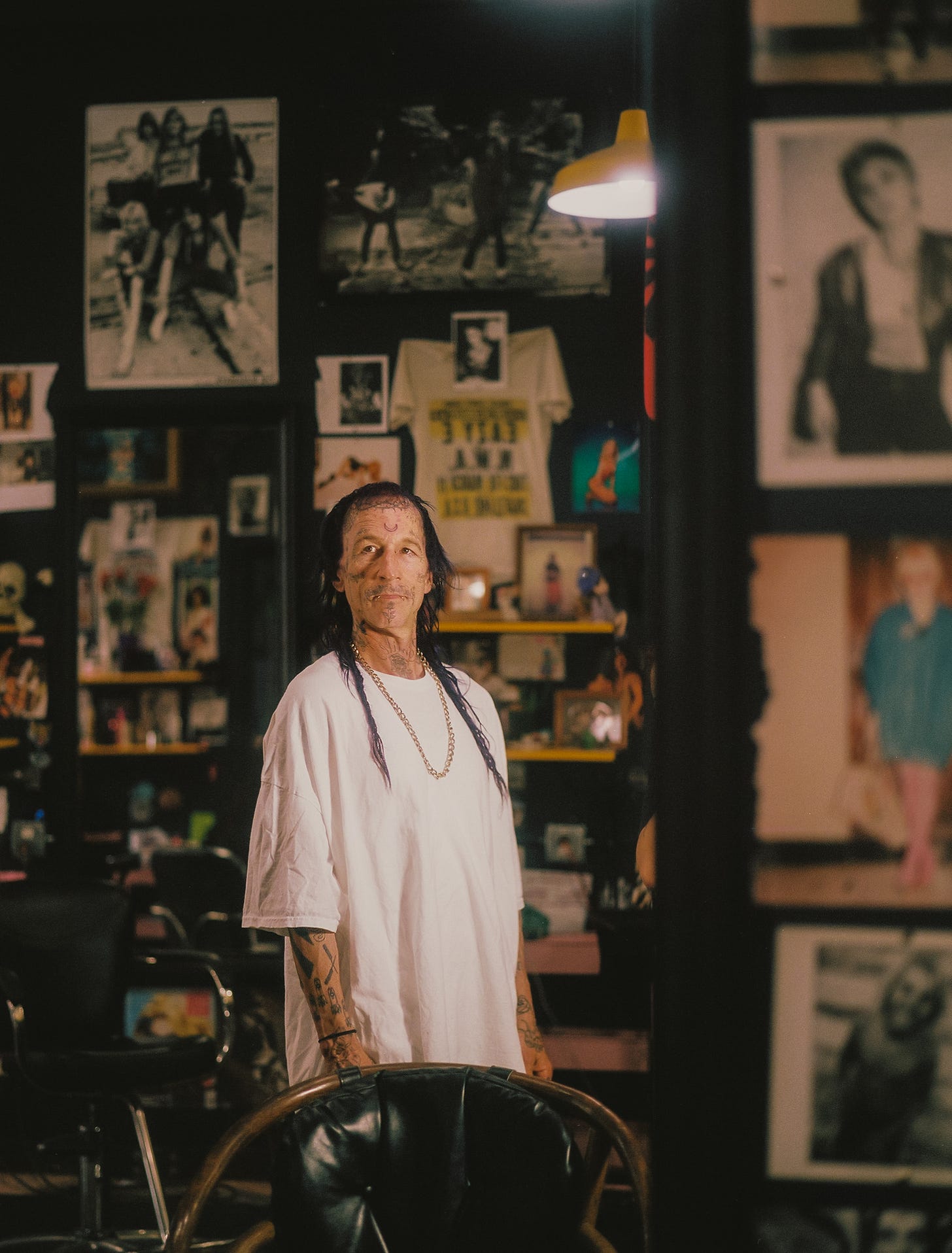
How Julio got into hair:
My sister was a hairdresser and she was doing a lot of punkers. I always thought, well, maybe I can do that.
That way I don't have to cut my hair. That's when I decided to go to beauty school. Once I got there, I realized that it was really hard. Back then, beauty school took a couple years.
I got my first job as an apprentice in Beverly Hills with a celebrity hairstylist. By the time I got out of school, my hair was past my ass. It was ridiculous. People were really responding to that.
As I got started, grunge kind of came in and took over. That was a good thing because I already fit in.
Before grunge, in my first five years, I had to wear a suit to work. It was very formal then.
Grunge came like a wrecking ball down the runway and just kicked all those suits. All of a sudden, suits weren't cool for men anymore. It was, jeans, boots, and t-shirts, and jackets, and flannels.
Then I started interviewing and I got a job at the place I ended up staying for 18 years. It was called Stilo Salon. I got a job there in 1994 and that's where Prince's hair stylist, Stevie Nicks hair stylist, David Bowie's hair stylist worked. Every celebrity was going there and it was the most popular place in the city.
That's where I started doing the Backstreet Boys and Incubus, Marilyn Manson, Nine Inch Nails, all those bands were coming in. I was getting to do their hair because all my other bosses were doing bigger celebrities.

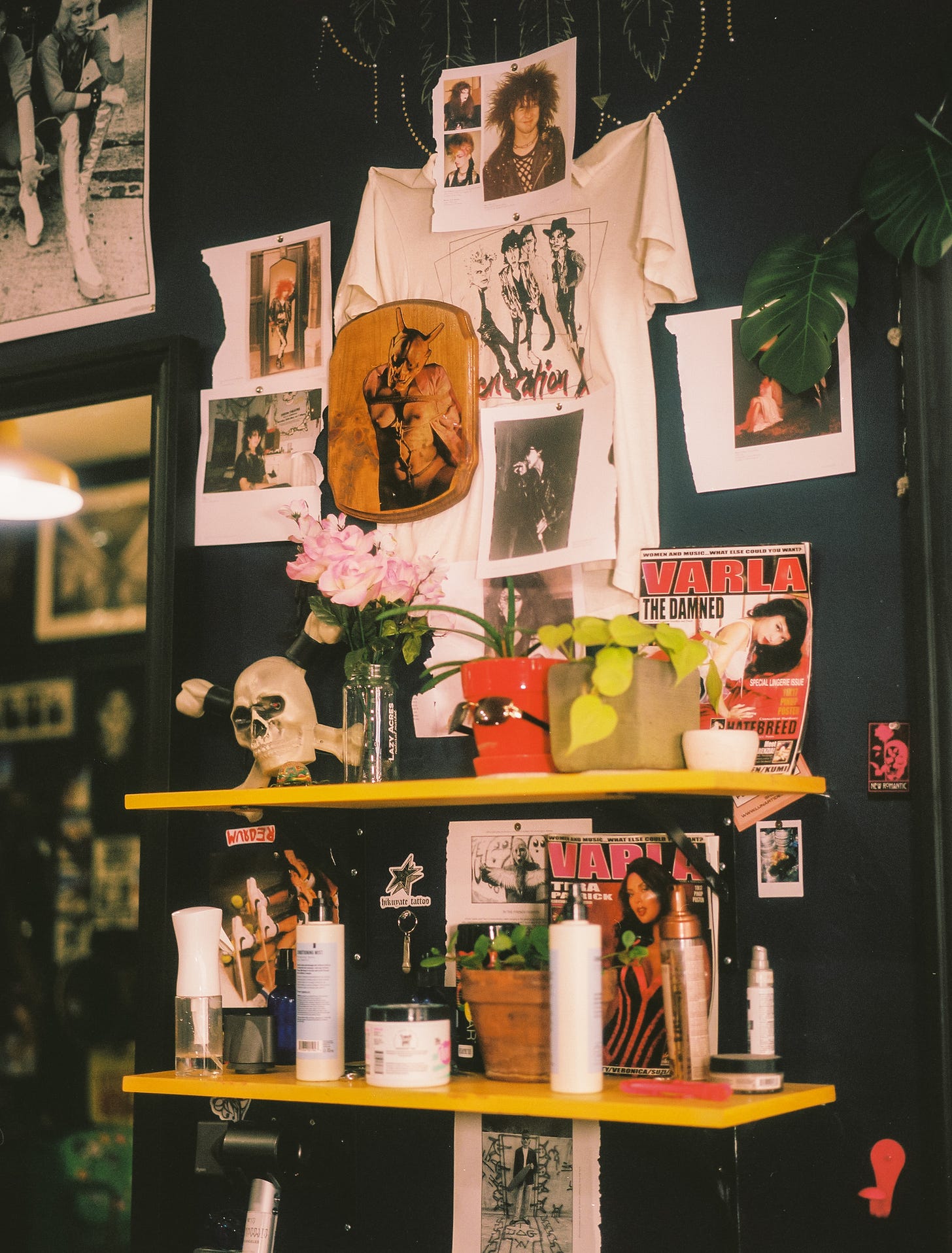
Leaving Estilo Salon and starting Shampoolio:
Things changed and we were entering into the Kardashian phase of fashion. A lot of the original essence and creativity got sucked out of the room and a lot of infighting happened
I no longer felt comfortable. I didn't really fit in where they were heading. My clients were starting to get weirded out by the lame music they were playing.
I started coming to the Eastside and I started having a lot of fun.
I knew this area because I went to LACC. I had lost my virginity on Vermont and Santa Monica Boulevard at fucking age 15. This neighborhood means a lot to me.
I was going to bring the high end, attention to detail with the funkiness of the East side, because I'm from the East side. I wanted it to be authentically me.
The vision of Shampoolio:
Botox and fillers took over the industry, a lot of salons were sharing that space with those people. It became very clinical in 2001, two, three, four.
I wanted to really bring back the original art and charm of where I came from. And I really wanted it to be like an art space and, but also a high functioning hair salon. The people who work here and the people who come here are the art.
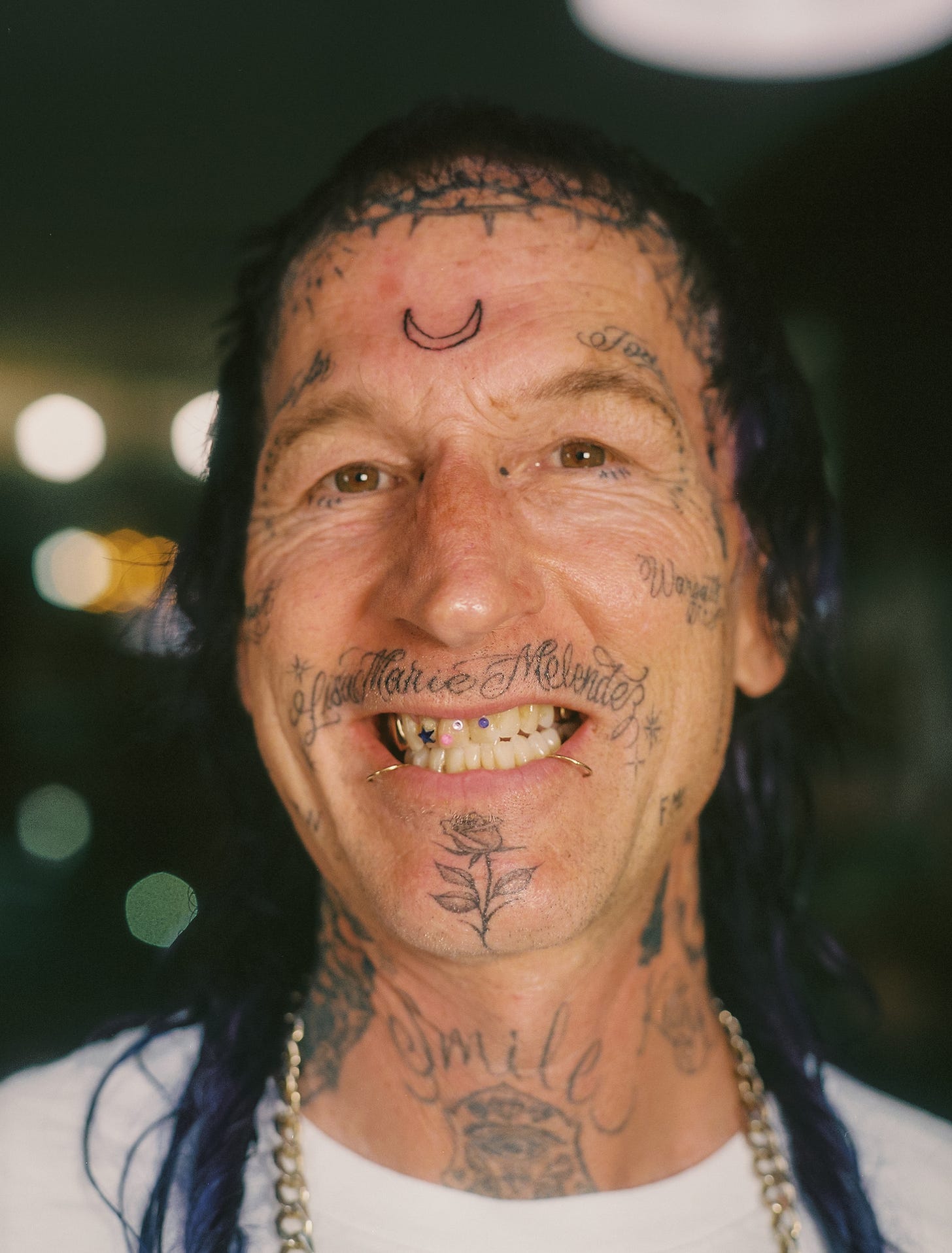
Reflections on Shampoolio:
You never stop learning, especially on the street.There's always layers to things. I just feel lucky to be a part of it and live through that. But also what's happening now is just as important. We have so many young people coming in [to Shampoolio] that are really into punk, metal, and goth again because their parents were.
And we also have a team of people with a lot of synergy and camaraderie. The work that we're doing is very high level and it looks like a lot of fun, but it takes a lot of focus. We have a rare combination of wildness meets focus.
These doors open, we're right on the street. We're very street level. People really appreciate how accessible it is. There's nobody in the way. There's no front desk. There's no person checking you in that doesn't do hair. We don't want management.
For Latinos, queers, punks, Black, Asian, whoever's coming in, they feel safe. That does not exist in this industry in the entire city. Suddenly this concept is getting hot and I see other people are starting to duplicate, which is great.
This place is authentic. It’s in my blood. I was able to create the space without any barriers or without reinterpreting the region because I am from here.
A lot of my workers are from here, so therefore the region is very authentic to us. A lot of salons, the people [who work there] are not from here. They're reinterpreting the region through their eyes of what they think Hollywood should be, West Hollywood should be, Beverly Hills.
Some of the rock stars that I worked with in the 90s and whatnot, and some of the people, the actors and stuff that I worked with, they, they still come here. And so they're blown away because they've never seen it happen like this. They're like, holy fuck, this is great. I'm never going anywhere else again. Everything else sucks.
When you have all like minded people here, there's no curmudgeon to stop things. It's pure flow, love, art, music, fashion, that's the definition of a salon. It's a hangout.
I was always the wild card. Now it's a room full of them.

His style and LA identity:
Look at me right now. I am a mirror of all of those eras.
My style is 80s gangster, like 80s cholo. It's how I dress and that's truly how I feel best represents me now. A lot of my style is very similar to when I was younger. It's just the older I get, the more extreme I get with it. I like to look ridiculous.
I'm very influenced by gang culture, tattoo culture, spray paint culture. That's all I've known. That is who I am at my core still: A true representation of LA culture. And I proudly display that with so much love and respect.
I worked really hard on my image. And I love it. I need to look this way in order to feel and be happy. To have extreme expression like this and to be able to live that out without an ego and a major sense of humor, my 50s are amazing.
People think of LA and they're like, “we're so flaky” and all of that, but the truth is, if you've actually grown up here, that is not true at all. You've gotten your ass kicked all the way up, and you're very strong and tough.
It's the other fuckers that come here and make that happen, and then we get that reputation.
I'm able to walk through gang neighborhoods. They leave me alone because I'm old enough. Also, my spirit is grounded here because I've been here for so long.Therefore, I don't act weird in those places. I know how to behave.
I have to understand how to operate in those spaces. Cause I don't like to be in the way or fuck up their rhythm. I want to be fluid, but to some people I'm horrifying, to other people they love it, but there's always an opinion. So when I walk in, I have to be prepared for that. And so if my energy's off, that fucks things up.
I have to be clean, spiritually clean.
Volunteering in MacArthur Park:
When I was in junior high, we used to go to MacArthur Park to score acid and PCP and weed and got my first fake ID there. I was there causing trouble. Now that I'm older and I've cleaned up and I want to be a part of the solution.
Being in the business for so long, you learn how to throw things on people and light them up. You know, from working with celebrities, rock stars, and all that. So we're taking that to MacArthur Park and we're lighting up these people that are trying to get on their feet.
We go every month. We’ve never missed a month in over two years. I get there early every time and I show up and they're happy to see me and they know my name. If you can give people something to rely on when they have nothing to rely on, that changes their life. These people have very few reliances anymore, but they know me and Sarah [a hair stylist at Shampoolio who suggested volunteering] will be there every four weeks and they are happy to see us and we bring love and we make them look amazing and there's no money exchange.
Whatever I see that's happening there, I don't judge it. I just want to help. And every time I leave there, I'm higher than any heroin, meth, oxy, whatever the fuck. I'm so high from helping.I feel very grounded being there.
It's pure love. We sometimes do 30-40 haircuts each and you're dead leaving there, physically, but mentally you're high as a kite, so you float out of there.
When you truly find what you're on this earth for, you will get higher from that than anything else that could be a drug or a drink or whatever. And that's when you're really living.
Riding his bike around LA:
Back in the day there used to be this one guy and his name was Spaz Attack and he was a fashion designer and a punk rocker. My mom would buy his clothes and he became friends with the family. He had three mohawks and would draw hieroglyphics between his mohawks. That's how ahead of his time he was.
Here I am at age 10, 11, 12 and I know this guy. We got along and he was into art, music, fashion, everything. We always had fun. Cut to many years later, that's who I represent when I go out in the world.
These tattoos and these hairdos and all of these things is what I saw. It's just my interpretation of what I saw. He was showing me, now I'm showing them. It's very important for people to see that. To see what's possible, what the extremes of fashion can be and to own that and be confident and without ego or anger, with love and sweetness, you can be whatever you want to be.
I feel that I'm an ambassador of the past. I feel that it's important to show myself in places and be seen. I do that lovingly.
I'm a people person and I enjoy socializing, and I don't really go to clubs or bars that much anymore cause I'm older.
That's kind of how I socialize during the day and being around East Hollywood, Silver Lake, Los Feliz, Echo Park, you really see street fashion and like street art.
And so the older you get, it's very important to stay connected to that because that's authentic. Nothing wrong with the gallery, but I want to see it first on the street.
Reflections on life:
Therapy was a big part of me becoming who I am and being comfortable in my own skin.Through therapy and meditation, I've been able to have self awareness.
There were times in my life where I wasn't proud of who I was. I had childhood trauma and addiction problems. I had to work through that and, and figure out who I am and what I am here for. And through the process of discovery, I figured out that I am Shampoolio and I'm here to help.
I want to help people in my own neighborhood and create reverberation ripples out from the epicenter of where we are.





